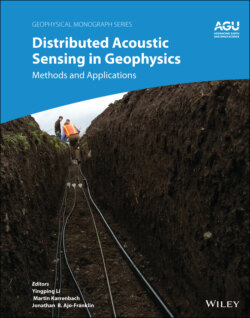Читать книгу Distributed Acoustic Sensing in Geophysics - Группа авторов - Страница 52
2.7.2. Strain, Strain Rate, and Particle Velocity
ОглавлениеGeoscientists are accustomed to working with geophone and seismometer data where the measurement is displacement, velocity, and acceleration—while strain and strain rate data not as commonly used. Daley et al. (2016) described one method to convert from strain rate to an equivalent geophone response. Here, we generalize the process. Figure 2.10 shows the relationship between the various products that can be produced from a DAS data set. The native measurement from an IU is the phase from Equation 2.1. From a simple scalar multiplication, the relative strain from Equation 2.2 can be obtained. Converting the relative strain to strain rate requires a simple time derivative to be applied; to convert the strain rate data to velocity requires a spatial integration. One might think that velocity is the final destination for our processing, but, if it is necessary to compare it to geophone data, then the instrument response of the geophone should be included as the last step to simulate geophone data. Further, it is possible to go backward from the simulated geophone response, or actual geophone data, to any of the previous products using the inverse operation.
There have been many published comparisons of DAS and geophone data sets (Mestrayer et al., 2011; Willis et al., 2016; Olofsson & Martinez 2017; Wu et al., 2017). Favorable geophone data comparisons were published using both strain rate and strain rate converted to geophone response. Using relative strain data appears quite attractive because it is much richer in low frequencies. Recall that the time derivative to convert relative strain to strain rate is a linear ramp function in the frequency domain, significantly reducing low frequencies and boosting high frequencies. However, as observed in Figure 2.5, relative strain data are quite sensitive to the temperature drift that often swamps in amplitude the desired seismic signal. From a practical point of view, if the goal of acquiring DAS data is to obtain geophone‐like data, then using strain rate or strain rate converted to geophone response is attractive. However, if the goal is low‐frequency deformation or earthquake measurements, then it is possible that, with careful filtering of the relative strain data, it would be the best option.
